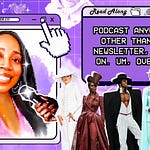I’m not a sports girl (Though I’m definitely cosplaying one until OKC wins the NBA finals. OKLAHOMA STAND UP!). I am, however, a culture girl, and Angel Reese is at the center of a years-long cultural firestorm that reveals just how little has changed for Black women in the public eye.
The latest incident? A hard foul from Caitlin Clark during a heated WNBA matchup. Both women brushed it off as a “basketball play.” But online, things unraveled fast — Reese was booed, dragged, and reportedly subjected to racial abuse. The WNBA is investigating, but for those of us paying attention, the dynamics are clear.
The media frenzy around Angel Reese has always had a whiff of punishment: for using her natural style and charisma to forge a persona that reaches far beyond Basketball. And Caitlin Clark, despite doing many of the same things on the court, rarely gets the same vitriol.
I appreciated that the Guardian article pointed to the broader dynamics at play. And I appreciated the study that backed it up even more. Because when you spend any time in these discourse trenches, it’s easy to feel gaslit. It helps to have the receipts.
That double standard isn’t just anecdotal. A 2025 study by researchers at Rice University and the University of Illinois Chicago analyzed 779,000 tweets comparing public reactions to the same “you can’t see me” gesture both players made during the 2023 NCAA tournament. (SN: When I read the paper earlier this week, it was open access. It’s since been restricted. I have to wonder if that’s because of people misusing or misrepresenting the work.)
Researchers found that reactions to Reese overwhelmingly included racism, misogyny, and commentary on her class status. In contrast, Clark’s behavior was framed as competitive and admirable. They coded tweets, fed them into a machine learning model called RoBERTa, and found that public sentiment broke down along racial and gendered lines. No surprises. Just receipts.
Clark was celebrated. Reese was called “classless,” a “hoodrat,” “trashy.” It’s textbook cultural racism where Black expression is pathologized and white expression is celebrated.
This is why “visibility” is never neutral. Reese and Clark are drawing record attention to the WNBA — ticket sales, engagement, sponsorships — but that visibility brings scrutiny, racialized abuse, and sexist commentary. And when you add gambling to the mix (which the league is increasingly courting), the stakes get higher, and the threats get real.
That context matters when people like RG3 (Robert Griffin III) accuse Reese of “overreacting.” Thankfully, Ryan Clark clapped back. On The Pivot podcast, he called out RG3’s long history of criticizing Black women and cozying up to whiteness. Was it a little dramatic? Sure. But when Black women are under attack, I’ll take dramatic over silence any day.
Angel Reese is being judged by a completely different set of standards. And every time someone insists that it “isn’t about race,” they reveal how deeply embedded racial framing is in our discourse. You can’t claim moral superiority while repeating racist talking points. You can’t weaponize class, tone (imagine the anti-PC/anti-cancel culture brigade whining about tone), and appearance against Black women and pretend it’s neutral.
Of course this week Dave Portnoy stepped back into the chat right on time to loudly proclaim that his disdain for Reese has “nothing to do with race.”
Reese herself has shown grace in the face of this mess. But we shouldn’t expect her to carry it alone. The real concern isn’t just the hate she receives—it’s what that hate reveals. It’s about who gets to be seen as human, and who gets cast as a threat. Who gets protected. Who gets punished.
And what’s wild is that this could all be good for the WNBA. Drama, rivalries, tension — it draws attention. And attention draws money. But attention without care, without protection, without a willingness to name plain realities? That’s exploitation.
Angel Reese isn’t perfect. Nobody is. But she’s magnetic, self-possessed and completely deserving of the dignity typically granted doggedly competitive elite athletes.
Visibility always comes with a cost. The question is: who’s paying the price?












